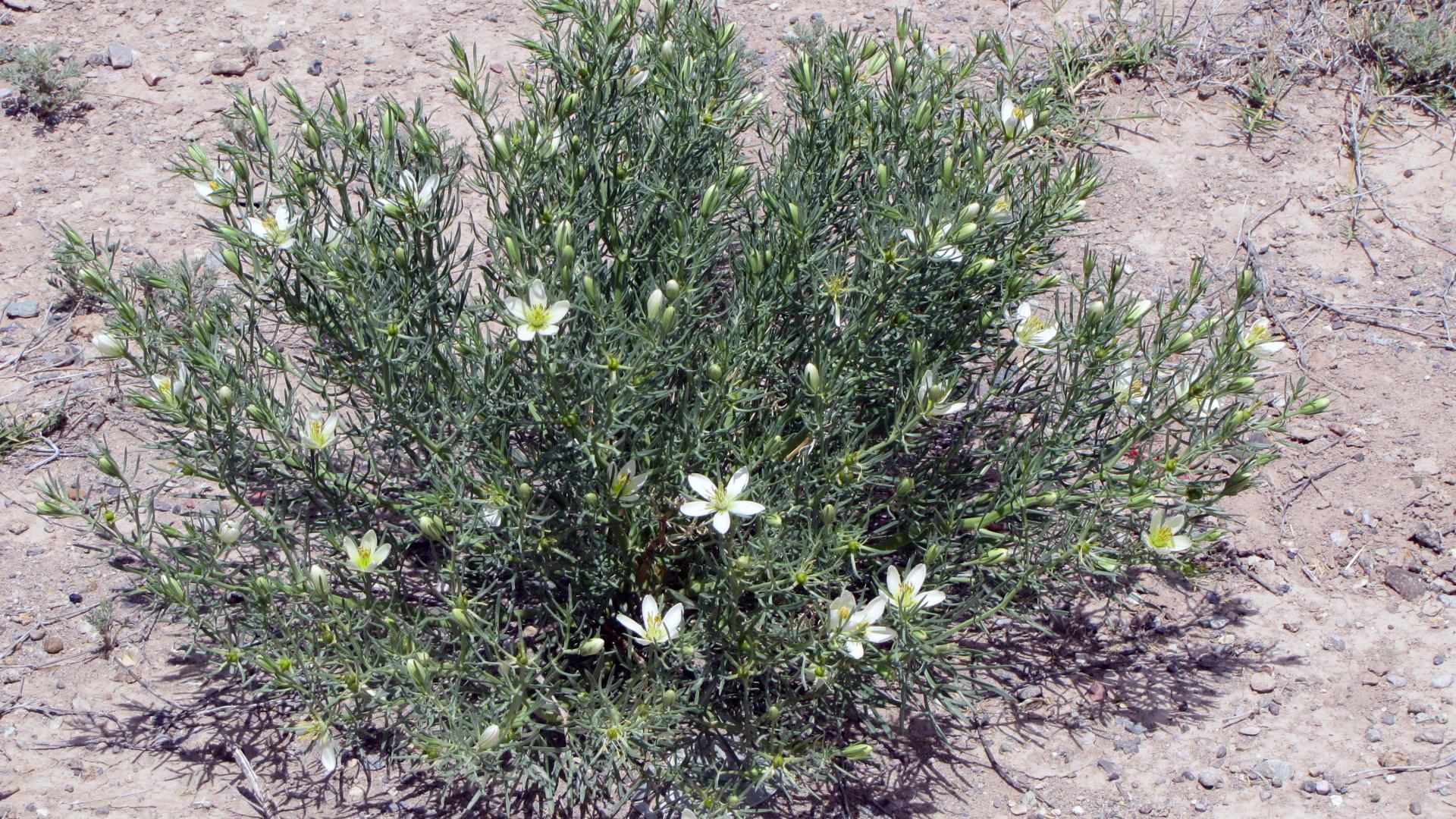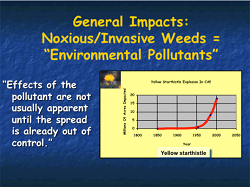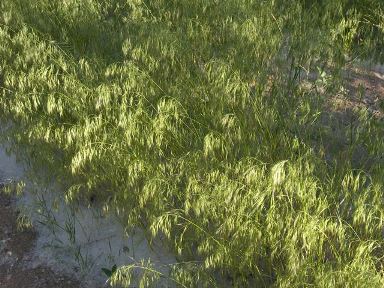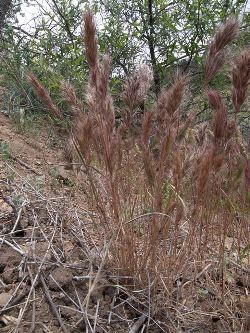
- Body
Learn about the basics of invasive species:
- Origins of Introduced Invasive Plants
- Common Characteristics of Invasive Plants
- Invasive Plants act as Environmental Pollutants
- Exponential Growth Associated with Invasive Plants
- Economics Associated with Invasive Species
- Examples -- Invasive Grasses
Origins of Introduced Invasive Plants
Some of the most problematic invasive plants (weeds) in the United States were introduced from Europe or Asia (Eurasia), Africa, and the Mediterranean region either purposely or by accident. Some invasive plants were introduced as ornamentals or with the intention of solving an environmental problem such as excessive soil erosion during the 1930’s, while others likely inadvertently hitched rides in ship ballasts, hay bales, or in agricultural seed. For more information on the origins and impacts of invasive plants watch the video Dangerous Travelers.
Common Characteristics of Invasive Plants
The reasons why some plants become invasive while others do not are extremely complex and depend on characteristics of the plant as well as the unique abiotic and biotic idiosyncrasies of the ecosystem where the plant grows. However, invasive plants often share one or more of the following characteristics:
- fast growth
- rapid reproduction
- high seed production and dispersal ability
- tolerance of a wide range of environmental conditions
- aggressive and prolific vegetative reproduction (massive root systems)
- association with humans or human activities (land management practices).
Also, non-native invasive plants may not have the natural predators in their new environment which helps them to proliferate unchecked.
Invasive Plants act as Environmental Pollutants
Nearly 20 years ago, Dr. Steven Dewey, a weed scientist (now retired) from Utah State University, suggested that invasive plants act as environmental pollutants, to wit:
- The pollutant weakens and kills native vegetation with endangered species being especially vulnerable.
- The pollutant spreads naturally in water, wind, and/or soil, but is also spread by wildlife, livestock, and recreationists.
- Affected lands cannot “heal” themselves over time - once polluted, always polluted.
- The effects of the pollutant are not usually apparent until the spread is already out of control.
Some common environmental and economic impacts of invasive plants include:
Environmental
- Degraded watersheds.
- Decreased biodiversity.
- Decreased forage and habitat for livestock and wildlife.
- Decreased soil moisture.
Economic
- Decreased land values.
- Poisonous plant problems for livestock.
- Increased erosion.
- Control costs.
The video Hunters and Anglers Against Invasive Species provides more detailed information on the many negative economic and ecologic impacts that invasive plants can have on the environment.
Exponential Growth Associated with Invasive Plants

Infestations that were initially just a few plants can increase rapidly to become several thousand acres. Invasive plants can sometimes lie “dormant” for decades, and then explode exponentially. One striking example of this phenomenon is yellow starthistle in California. This Eurasian plant is believed to have been inadvertently introduced into California in the mid-1800’s. By 1958, yellow starthistle had expanded its range to 1 million acres. It had expanded its range by another 7 million acres by 1985, and over the next 20 years it more than doubled its acreage to >15 million acres.
Exponential growth is just one of the many insidious characteristics of invasive plants. The cost of controlling invasive plants increases and the probability of successful control decreases as you move from left to right on the x-axis of the above figure. Unfortunately, humans tend not to get too excited about invasive plants until it is too late to effectively manage them ecologically or economically. Like so many things in life, the longer we wait to do something about it, the more damage it causes and the more expensive it becomes!
Invasive plant species have numerous effects on the ecosystem goods and services provided by rangelands. Those goods and services have value to society. In general, the invasive species will affect the quantity or quality of those goods and services.
On rangelands, most of the concern related to invasive species focuses on plants. Invasive plant species are discussed elsewhere on the website. This section will look at some of the economic considerations related to these plants.
Different authors have shown how invasive plants may affect native plant production, water quality, erosion rates, and recreation values and reduce livestock and wildlife forage and habitat, among other such impacts. In many cases, these effects have not been quantified, especially for different amounts of the invasive plant. For example, we would ideally want to know how wildlife habitat quality changes as a particular plant species increases.
From an economic standpoint, there are two types of economic effects. First are the change in values from each of the impacts. For example, if domestic forage is reduced, the animal numbers will either need to be reduced or alternative feed sources found. Either of those will likely reduce the net income to the rancher. Second are the costs associated with managing the invasive species. These costs include detection, control, and monitoring of the population.
Economic aspects have been measured in two different ways. The first is a cost-benefit type of analysis where the costs of controlling the species is compared to the change in value of the ecosystem goods and services being affected. The second, but related, way to look at economics is to evaluate how society spends money on control and the related impacts and then calculating how those values affect the regional economy.
In both methods, the cost of control is fairly straightforward. If chemical, mechanical, prescribed burning, or hand pulling is used, there will be a definite cost to the landowner. In a cost-benefit analysis, that cost is simply compared to the change in benefits. In the economic impact, the cost is calculated as money spent in different sectors — for example, chemicals purchased from a chemical company. In this case, the money spent circulates through the economy.
Benefits should include both market and nonmarket goods and services. Market goods and services include those things that are traded and have a cash value. An example of a market good is domestic livestock forage. Nonmarket goods and services are generally not traded and don't have a readily available monetary value associated with them. While a cost-benefit analysis should include both kinds, generally only market-valued benefits are included. For the economic impact analysis, only market-based values are considered.
The U.S. Department of Agriculture Natural Resources Conservation Service publishes average treatment costs for most states in their electronic Field Office Technical Guides (eFOTG) available from their website.
The objective of this section is to discuss key characteristics of the following invasive grasses that occur in the western United States: Buffelgrass, Fountain Grass, Cheatgrass, and Red Brome (scientific names appear below). Each of these grasses have the potential to become ‘ecosystem transformers’ due to their unique invasive properties. The following information will be discussed for each invasive grass species: 1) Impacts, 2) Key Characteristics for Site-Identification, and 3) Management Considerations.
Buffelgrass
Impacts
Buffelgrass - Key Characteristics for Site-Identification
- Common Names: buffelgrass, African foxtail grass, pasto buffel, zacate buffel
- Scientific Name: Pennisetum ciliare (L.)
- Family: Poaceae (Grass)
- Origin: Africa, Asia, the Middle East

Description: Buffelgrass is a perennial warm-season (C4) bunch grass that can reproduce by seed, rhizomes, and stolons. It was introduced into the southwestern U.S. from South Africa in the 1930s as a forage for cattle and to control erosion. It is a very robust grass that may grow over 3-feet tall and wide. Bristly flower heads range from 1.5 to 5 inches long and can be purple, gray, or yellowish, turning a distinctive golden-brown color when dry. Spikes are dense with bristly fruit which are actually burs without hardened spines. Although buffelgrass is a perennial it is an extremely prolific seed producer. Inflorescences may emerge whenever soil moisture is available. New plants produce seed in as little as six weeks. Older plants branch profusely and densely at nodes giving mature plants a “messy” appearance.
Buffelgrass - Management Considerations: Buffelgrass is extremely drought tolerant and reestablishes and expands its range quickly after fire. The Southern Arizona Buffelgrass Coordination Center (SABCC) has suggestions on the pros and cons for controlling buffelgrass using biological, chemical, cultural, prescribed fire, and mechanical control methods (click on the Control tab at the SABCC website). There are also interesting news releases concerning the use of aerial spraying to control buffelgrass that can be found by clicking on the In The News tab at the SABCC website. The Sonoran Desert Weed Wackers have been working hard to physically remove buffelgrass and other invasive grasses in and around Tucson for over a decade.Fountain Grass
Impacts
Fountain Grass - Key Characteristics for Site-Identification
- Common Name: fountain grass, crimson fountain grass
- Scientific Name: Pennisetum setaceum (Forsk. Chiov)
- Family: Poaceae (Grass)
- Origin: Africa, southwest Asia, the Middle East.

Description: Fountain grass is a coarse, perennial, warm-season (C4) bunchgrass that grows 2 to 3.5 feet tall. Tufted culms grow in dense, usually large, clumps. Red, rosy to purple, bristly, spike inflorescences are 2 to 4-inches long, and 0.75-1-inch wide. The 0.25-inch long spikelets are solitary or in clusters of 3 on white-hairy branches attached below the bristles. Flower heads are prominent, nodding, feathery, and attractive. Seeds can remain viable for up to 6 years and plants can live for up to 20 years. The cultivar 'Cupreum' is reported to be sterile (does not set seeds.)
Fountain Grass - Management Considerations: Fountain grass is found along roadways in southern Arizona, for example, and is expanding into rangelands as well as riparian areas. Palatability to wild and domestic herbivores is low which facilitates its competition with native plants. Like buffelgrass, it rapidly reestablishes after fire, is very difficult to control once established, but is manageable in areas where just a few spot infestations occur. The key is to rapidly control new infestations while they are still small. Click here to learn how land managers in California are dealing with this invasive grass (scroll down to ‘How Can I Get Rid Of It’).
Cheatgrass and Red Brome
Impacts
Overview: These two cool season (C3) annual grasses are discussed together because they are very similar in biology, ecology, and history and are separated mostly by prevailing temperature and elevation (although they do overlap in some areas). Both species respond favorably to cool season precipitation and tend to be more prevalent in disturbed areas. However, they are also found in areas with minimal disturbance across the western U.S. When cool season precipitation is favorable, massive amounts of cheatgrass and red brome biomass can accumulate in the natural open spaces between native plants and increase fine fuel loads in both cold deserts (cheatgrass) and warm deserts (red brome). Wet-dry cycles can dramatically increase the probability of unwanted wildfires after these species dry out and perpetuate the ‘annual grass-fire cycle’. These non-native annual grasses are adapted to respond quickly to the release of competition for space and nutrients following a burn. Also, hot fires can severely damage some native plant species that are not adapted to fire. Plant communities infested with these species burn much more often and hotter than before they were infested (e.g., every 5-10 years instead of every 100 years). Plant communities that are repeatedly burned become much more homogeneous (i.e., lower biodiversity), more susceptible to reinvasion, and provide fewer habitat values and ecosystem services.
Cheatgrass - Key Characteristics for Site-Identification
- Common Names: cheatgrass, downy brome, June grass, bronco grass, downy chess
- Scientific Name: Bromus tectorum (L.)
- Family: Poaceae (Grass)
- Origin: Eurasia, Mediterranean region.

Description: Cheatgrass can grow between 2 inches to 2 feet tall (depending on site conditions and the timing and amount of cool season precipitation). Like most annual plants, it is a prolific seed producer. It germinates during cooler temperatures and rapidly grows and sets seed before most other species. Seedlings are bright green with conspicuously hairy (downy) leaves, sheaths, glumes and lemmas. Seed heads are open, drooping, multiple-branched panicles with moderately awned spikelets. Auricles are absent. At maturity the foliage and seed heads often turn purplish before drying and then turn a brown or tan color after drying.Red Brome - Key Characteristics for Site-Identification
- Common Names: red brome, foxtail chess
- Scientific Name: Bromus rubens (L.)
- Family: Poaceae (Grass)
- Origin: Eurasia, Mediterranean region.

Description: Red brome grows 8 to 20 inches tall (depending on site conditions and the timing and amount of cool season precipitation) with several to numerous stems from an erect to spreading base. Seed heads are reddish-purple as they ripen and form a dense, compact panicle (similar to a spike) that is 2-3 inches long. As seed heads dry they turn a tawny to brown color. Leaf blades are short, narrow, flat and hairy, with prominent veins. Leaf sheaths are papery. Red brome occurs on disturbed and undisturbed sites in various soil types but is typically found in warmer climates and lower elevations than is cheatgrass, a close relative.